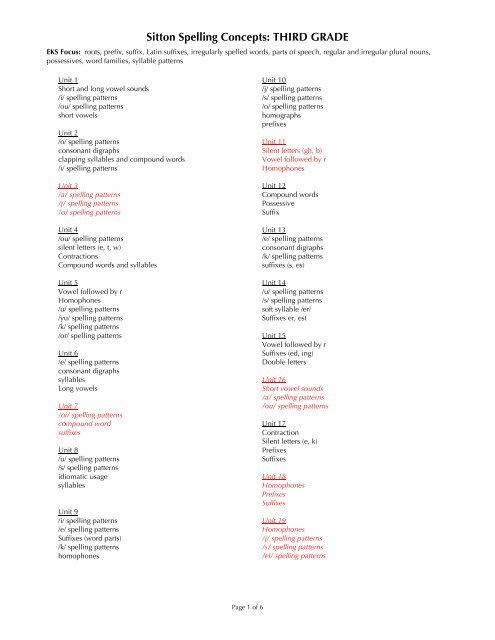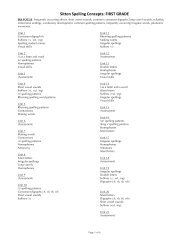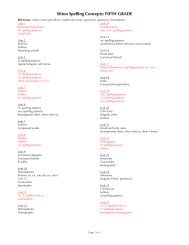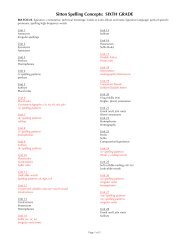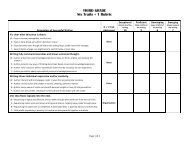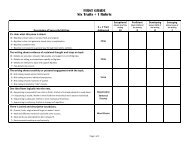Sitton Spelling Concepts THIRD GRADE
Sitton Spelling Concepts: THIRD GRADE
Sitton Spelling Concepts: THIRD GRADE
Create successful ePaper yourself
Turn your PDF publications into a flip-book with our unique Google optimized e-Paper software.
<strong>Sitton</strong> <strong>Spelling</strong> <strong>Concepts</strong>: <strong>THIRD</strong> <strong>GRADE</strong>EKS Focus: roots, prefix, suffix, Latin suffixes, irregularly spelled words, parts of speech, regular and irregular plural nouns,possessives, word families, syllable patternsUnit 1Short and long vowel sounds/i/ spelling patterns/ou/ spelling patternsshort vowelsUnit 2/o/ spelling patternsconsonant digraphsclapping syllables and compound words/i/ spelling patternsUnit 3/a/ spelling patterns/j/ spelling patterns/o/ spelling patternsUnit 4/ou/ spelling patternssilent letters (e, t, w)ContractionsCompound words and syllablesUnit 5Vowel followed by rHomophones/u/ spelling patterns/yu/ spelling patterns/k/ spelling patterns/or/ spelling patternsUnit 6/e/ spelling patternsconsonant digraphssyllablesLong vowelsUnit 7/oi/ spelling patternscompound wordsuffixesUnit 8/u/ spelling patterns/s/ spelling patternsidiomatic usagesyllablesUnit 9/i/ spelling patterns/e/ spelling patternsSuffixes (word parts)/k/ spelling patternshomophonesUnit 10/j/ spelling patterns/s/ spelling patterns/o/ spelling patternshomographsprefixesUnit 11Silent letters (gh, b)Vowel followed by rHomophonesUnit 12Compound wordsPossessiveSuffixUnit 13/e/ spelling patternsconsonant digraphs/k/ spelling patternssuffixes (s, es)Unit 14/u/ spelling patterns/s/ spelling patternssoft syllable /er/Suffixes er, estUnit 15Vowel followed by rSuffixes (ed, ing)Double lettersUnit 16Short vowel sounds/a/ spelling patterns/ou/ spelling patternsUnit 17ContractionSilent letters (e, k)PrefixesSuffixesUnit 18HomophonesPrefixesSuffixesUnit 19Homophones/j/ spelling patterns/s/ spelling patterns/el/ spelling patternsPage 1 of 6
<strong>Sitton</strong> <strong>Spelling</strong> <strong>Concepts</strong>: <strong>THIRD</strong> <strong>GRADE</strong>Unit 20Double lettersSyllablesHomophonesSuffixes (vowel-consonant)Unit 21/oi/ spelling patternsprefixes (re)suffixes – consonant yUnit 22/e/ spelling patternssuffix lyhomophonessuffixes – final silent eUnit 23Contraction/k/ spelling patternsvowel follows by rhomophonesUnit 24PossessivesPrefixesSuffixesApostrophesUnit 25/s/ spelling patterns/or/ spelling patternssuffixescompound wordsUnit 26Silent lettersIrregular verbsSuffixesHomophonesUnit 27/k/ spelling pattern/sh/ spelling patternvowel follows by rUnit 28/u/ spelling patternsuffixes/er/ spelling patternsirregular verb formsUnit 29Soft syllable endings /el/ /er//ou/ spelling patternconsonant blendsUnit 30HomophonesAntonymsDouble letters stand for 1 soundCapital lettersSurprise wordsUnit 31/i/ /e/ end spelled with yapostrophes in contractions and possessivescompound wordscontractionsUnit 32Consonant digraphsSuffixHomophonesUnit 33Double lettersSuffixBreak words at syllablesPage 2 of 6
<strong>Sitton</strong> <strong>Spelling</strong> Required Units: <strong>THIRD</strong> <strong>GRADE</strong>Unit 1Seeds forSowing SkillsTest ReadyWord PreviewShort vowel sounds are usually spelled with one vowel.Long vowel sounds are usually spelled with two vowels.Frequent spelling patterns for /i/ are y, igh, ind, i, and i-consonant-e.<strong>Spelling</strong> patterns for /ou/ are ou and ow.Short vowelsCloze Story Word TestUnit 2Seeds forSowing SkillsTest ReadyWord PreviewFrequent spelling patterns for /o/ are oa, ow, old, o, and o-consonant-e.When h follows c, s, t, or w, the combination stands for a new sound.Words are easier to spell when each word part is spelled separately.Long /i/ and /o/ spelling patternsCloze Story Word TestUnit 4Seeds forSowing SkillsTest ReadyWord Preview<strong>Spelling</strong> patterns for /ou/ are ou and ow.Some words have silent letters.A contraction is a combination of two or more words with an apostrophe replacing a letter or letters.Words are easier to spell when each word part is spelled separately./ou/ spelling patternsCloze Story Word TestUnit 5Seeds forSowing SkillsTest ReadyWord PreviewA vowel followed by r stands for a new sound.Homophones are words that sound the same but have different spellings and meanings.Frequent spelling patterns for /u/ are ew, ue, u-consonant-e, oo, u.Frequent spelling patterns for /yu/ are ew, ue, u-consonant-e, u.Frequent spelling patterns for /k/ are c, k, ck, qu, ch./or/ spelling patternsCloze Story Word TestUnit 6Seeds forSowing SkillsTest ReadyWord PreviewFrequent spelling patterns for /e/ are e, ea, ee, and y.When h follows c, s, t, or w, the combination stands for a new sound.Words are easier to spell when each word part is spelled separately.Long vowel spelling patternsCloze Story Word TestPage 3 of 6
Unit 8Seeds forSowing SkillsTest Ready<strong>Sitton</strong> <strong>Spelling</strong> Required Units: <strong>THIRD</strong> <strong>GRADE</strong>Word PreviewSome sounds are spelled more than one way (/u/ spelling patterns)Irregular verb forms do not use the suffix –ed.Frequent spelling patterns for /s/ are s, ss, ce, ci, and cy.Idiomatic usage is different than the literal meaning.Words are easier to spell when each word part is spelled separatelyA simile shows how two things are similar using linking words like like or as.Homophones are words that sound the same but have different spellings and meanings./s/ spelling patternsCloze Story Word TestUnit 9Seeds forSowing SkillsTest ReadyWord PreviewFrequent spelling patterns for /i/ are y, igh, ind,i, and i-consonant-e.Adding prefixes and suffixes to a base word creates a new word.Some sounds are spelled more than one way (Often a short vowel word can become a long vowel word by adding avowel).Words are easier to spell when each word part is spelled separately (syllables)A suffix is a word part that can be put at the end of a base word.Frequent spelling patterns for /k/ are c, k, ck, qu, and ch.Homophones are words that sound the same but have different spellings and meanings.HomophonesCloze Story Word TestUnit 10Seeds forSowing SkillsTest ReadyWord PreviewFrequent spelling patterns for /j/ are j, ge, gi, and gy.Frequent spelling patterns for /s/ are s, ss, ce, ci, and cy.Frequent spelling patterns for /o/ are o, al, au, and aw.Homographs are words that have the same spelling but have different meanings and pronunciations.A prefix is a letter or letters added to the beginning of a word./j/ spelling patternsCloze Story Word TestUnit 12Seeds forSowing SkillsTest ReadyWord PreviewA compound word is a combination of two or more words.A possessive is a word that shows ownership. Some possessives need an apostrophe.A suffix is a letter or letters added to the end of a word.Compound wordsCloze Story Word TestUnit 13Seeds forSowing SkillsTest ReadyWord PreviewFrequent spelling patterns for /e/ are e, ea, ee, and y.When h follows c, s, t, or w, the combination stands for a new sound.A suffix is a letter or letters added to the end of a word.Frequent spelling patterns for /k/ are c, k, ck, qu, and ch.Idiomatic usage is different than the literal meaning.Suffixes (-s, -es)Cloze Story Word TestPage 4 of 6
Unit 14Seeds forSowing SkillsTest Ready<strong>Sitton</strong> <strong>Spelling</strong> Required Units: <strong>THIRD</strong> <strong>GRADE</strong>Word PreviewFrequent spelling patterns for /u/ are u, oo, ew, ue, and u-consonant-e.Idiomatic usage is different than the literal meaning.Frequent spelling patterns for /s/ are s, ss, ce, ci, and cy.Frequent spelling patterns for words with soft-syllable endings include /er/ spelled er, or, and ar.-er is a comparative suffix. It can also mean “one who.”Suffixes (-er, -est)Cloze Story Word TestUnit 15Seeds forSowing SkillsTest ReadyA vowel followed by r stands for a new sound.Er can be a suffix or a part of the base word.A suffix is a letter or letters added to the end of a word.Double letters stand for one sound.Suffixes (-ed, -ing)Word PreviewCloze Story Word TestUnit 17Seeds forSowing SkillsTest ReadyWord PreviewA contraction is a combination or two or more words with an apostrophe replacing a letter or letters.Homophones are words that sound the same but have different spellings and meanings.Its and It’s are homophones. One is a contraction, the other is a possessive pronoun.Some words have silent letters.A prefix is a letter or letters added to the beginning of a word.A suffix is a letter or letters added to the end of a word.ContractionsCloze Story Word TestUnit 20Seeds forSowing SkillsTest ReadyWord PreviewDouble letters stand for one sound.For words ending in a vowel-consonant, you often double the consonant before adding a suffix that begins with avowel.Words are easier to spell when word parts are spelled separately (syllables).Suffixes for words ending in vowel-consonantCloze Story Word TestUnit 22Seeds forSowing SkillsTest ReadyWord PreviewFrequent spelling patterns for /e/ are e, ea, ee, and y.Frequent spelling patterns for /i/ are y, igh, ind, i, and i-consonant-e.A suffix is a letter or letters added to the end of a word.Homophones are words that sound the same but have different spellings and meanings.Suffixes for words ending in final silent eCloze Story Word TestPage 5 of 6
Unit 24Seeds forSowing SkillsTest Ready<strong>Sitton</strong> <strong>Spelling</strong> Required Units: <strong>THIRD</strong> <strong>GRADE</strong>Word PreviewA possessive is a word that shows ownership. Some possessives need an apostrophe.A prefix is a letter or letters added to the beginning of a word.A suffix is a letter or letters added to the end of a word.Apostrophes in possessives and contractionsCloze Story Word TestUnit 25Seeds forSowing SkillsTest ReadyWord PreviewFrequent spelling patterns for /s/ are s, ss, ce, ci, and cy.A compound word is two smaller words put together.Some words are spelled the way they sound, while others are not.A suffix is a letter or letters added to the end of a word.Compound words.Cloze Story Word TestUnit 26Seeds forSowing SkillsTest ReadyWord PreviewSome words have silent letters.Antonyms are words that have opposite meanings.Irregular verbs and irregular plural nouns usually do not use suffixes.A suffix is a letter or letters added to the end of a word.Homophones are words that sound the same but have different spellings and meanings.Silent lettersCloze Story Word TestUnit 28Seeds forSowing SkillsTest ReadyWord PreviewSome sounds are spelled more than one way.Homophones are words that sound the same but have different spellings and meanings.A suffix is a letter or letters added to the end of a word.A prefix is a letter or letters added to the beginning of a word.Frequent spelling patterns for words with soft-syllable endings include /er/ spelled er, or, and ar.Irregular verb forms.Cloze Story Word TestUnit 31Seeds forSowing SkillsTest ReadyWord PreviewAn /i/ or /e/ at the end of a word is usually spelled y.A suffix is a letter or letters added to the end of a word.An apostrophe is used in a contraction and in some possessives.Homophones are words that sound the same but have different spellings and meanings.A compound word is a combination of two or more words.ContractionsCloze Story Word TestPage 6 of 6


